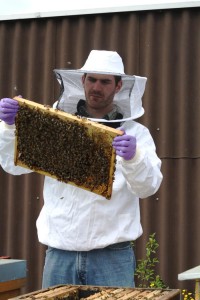By Bernadette Calonego
Canadian bee expert Geoffrey Williams knows what a bee wonderland looks like. It is a place where swarms of honey bees live peacefully, are stress-free and healthy — and almost never sting. It is a virtual bee paradise.
These perfect conditions exist on the island of Newfoundland, in eastern Canada. Williams wants it to stay that way, and that is the reason why he has travelled to Switzerland, where he is currently based in Liebefeld near Bern at the Swiss Bee Research Center. Thanks to the state-run agricultural research organisation Agroscope, he is studying the threats and diseases bees are often exposed to — and figuring out how to prevent them from ever reaching Newfoundland.
Both Swiss and Newfoundland bees belong to the same genus of European honey bee (Apis mellifera), which are remarkably friendly. “I’ve been here three months now and I’ve never been stung,” says 28-year-old Williams, who spent four years researching at Dalhousie University in the Canadian province of Nova Scotia. He had quite a different experience while in Arizona, where he was once stung by some 50 killer bees in just 20 minutes.
 In the United States, the bee population is in turmoil. Last winter about a third of all US bees were wiped out by parasites, viruses and other diseases. One such parasite is the small hive beetle, whose larvae damage the honeycomb when they eat their way through it. The adult insect then mimics a bee and teaches other bees to feed it with honey. In Canada, the beetle has only been detected in one small area. The island of Newfoundland has, like Switzerland, so far been spared a small hive beetle infestation.
In the United States, the bee population is in turmoil. Last winter about a third of all US bees were wiped out by parasites, viruses and other diseases. One such parasite is the small hive beetle, whose larvae damage the honeycomb when they eat their way through it. The adult insect then mimics a bee and teaches other bees to feed it with honey. In Canada, the beetle has only been detected in one small area. The island of Newfoundland has, like Switzerland, so far been spared a small hive beetle infestation.
The Deadly Varroa Mite
But unlike Newfoundland, Switzerland is home to bees’ most infamous nemesis, the varroa mite, Latin for “destructor mite.”
“It’s a completely one-off case that this mite hasn’t been found in Newfoundland,” says Geoffrey Williams. “There are two reasons for this. Newfoundland is geographically isolated, and there are also very strict rules regulating bee imports and quarantine procedures.”
In Switzerland, the Nosema ceranae parasite has also caused much damage, by attacking the bees’ stomach, causing diarrhea and death. In Spain these parasites have been responsible for the destruction of countless bee colonies. In the US, experts have recently traced the so-called “colony collapse disorder” back to the parasite.
Beekeepers in Newfoundland must remain vigilant, even if the island is free of the most dangerous threats to bee populations. And Canadian bee researchers have to know their enemy before they can fight against it. In Liebefeld Geoffrey Williams has been identifying the parasites that pose the greatest threat, and which Newfoundland must develop defenses against. He has been sharing his insights with other Canadian beekeepers.
His findings could also prove useful for Swiss beekeepers. Williams is examining bees for parasites and exploring the interaction between these parasites and pesticides and their potential effects on Swiss bees. Working on a research project sponsored by the Swiss Ricola Foundation, Williams would like to determine the exact amount of chemicals that bees can tolerate, and their best combinations.
Since there are no bee diseases in Newfoundland, there is no need for beekeepers there to use chemicals and the bee population thus remains free of pesticides. But Williams does not believe that importing bees from abroad should be regarded as the primary solution to local problems. “Switzerland shouldn’t have to resort to importing bees to maintain the local population,” he says. When animals are moved from one country to another, there is always an element of risk involved – diseases can easily be spread in this way.
Stress-Free Honey
There is one other resemblance between Swiss and Newfoundland bees. Compared to other bee populations, they are subject to less stress because they are primarily used to produce honey and are less frequently used to fertilize fields – a process that involves transporting them from one place to another.
In Newfoundland as in Switzerland, the average beekeeper only keeps a few colonies – far fewer than beekeepers in the United States. In Newfoundland, which counts only five breeders and about 150 colonies, only a negligible amount of honey is produced. But that could all change if the Newfoundland became one of the few places in the world able to offer chemical-free, organic honey.
